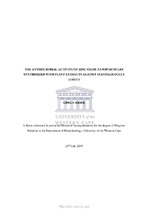| dc.description.abstract | Nanoparticles using a green synthesis production method is of increasing interest for
biomedical applications. Zinc oxide is currently used in medicinal and cosmetic formulations,
and zinc oxide nanoparticles have potential in biomedical applications. Antibiotic-resistant
bacterial infections are of growing concern globally, and novel antimicrobial agents are
drastically needed. In this work, zinc oxide nanoparticles were synthesized using Calendula
officinalis flowers aqueous extract and zinc nitrate hexahydrate using a single-pot green
synthesis approach. The synthesized particles were calcined and characterised using UV-Vis
spectrophotometry, Dynamic Light Scattering (DLS), X-Ray Diffraction (XRD), Transmission
Electron Microscopy (TEM), Scanning Electron Microscopy (SEM), Thermogravimetric
Analysis (TGA), Fourier-Transform Infrared Spectroscopy (FTIR) and Nuclear Magnetic
Resonance Imaging (NMR). Quasi-spherical, hexagonal phase zinc oxide nanoparticles with
core size <10nm according to TEM and average size of ~53nm according to XRD were
successfully synthesized. The particles tended towards agglomeration. Antioxidant assays were
run to determine the reducing power, antioxidant activity, and presence of polyphenols in the
final products. The final product possessed antioxidant activity, polyphenols and had reducing
power, confirming the constituents from Calendula officinalis playing a role in the reduction
of the zinc ions and capping of the zinc oxide nanoparticles. Minimum inhibitory
concentration of the samples by tube dilution was conducted to determine potential of the
samples as antimicrobial agent against methicillin-resistant Staphylococcus aureus, using
Clindamycin as control. Results of antimicrobial studies indicate the need for investigation of
MIC using a variety of concentrations of the samples, and a variety of solvents, in order to
determine exact MIC values. Further work is needed to improve the methodology to obtain
particles that have a narrow size distribution, that are well dispersed, and are of higher
concentration to be considered for antimicrobial use in the biomedical field. | en_US |

